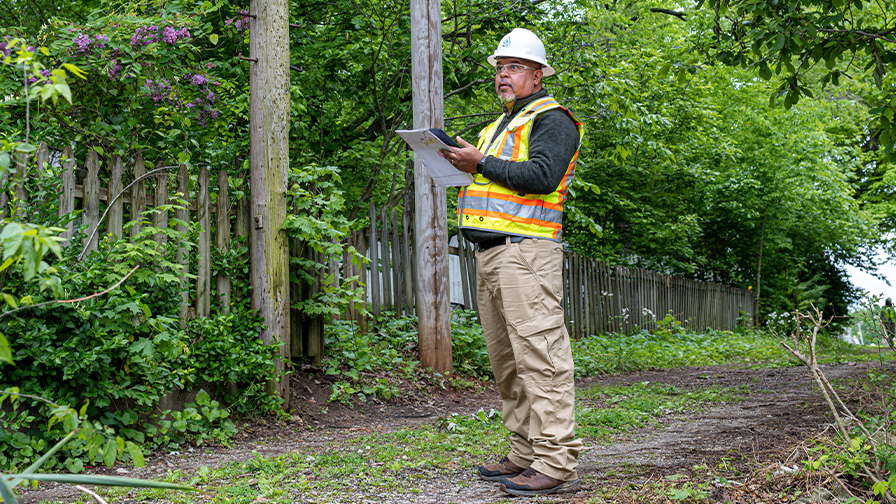- Vegetation Management Services
- Industries
- In Your Neighborhood
- About
- Careers
- Webinars
- Articles
Use Vegetation Data Intelligently to Drive Successful Rate Case Applications

Use Vegetation Data Intelligently to Drive Successful Rate Case Applications
By Rich Alexander, Product Manager, ACRT Services
A Long-Term Process with an Even Longer-Term Impact
As a professional working at an investor-owned utility (IOU), you will undoubtedly be familiar with an important process known as a rate case (also called a distribution rate case). This monumental undertaking involves virtually every department and function in the utility in order to prepare an extensive application to increase the utility’s rate to customers for delivering their power, water, or gas.
Whether a rate case is conducted annually, every few years, or once every other decade ultimately depends on the utility, its circumstances, and its long-term financial needs, but it is generally required in order to justify and receive approval for an increase in the cost of service to its customers. If you’ve worked on a rate case before, you’ll know the timeline and process can be extensive — let alone the actual rate case application itself.
Typically anywhere from a few to several thousand pages, rate cases provide in-depth information and analysis on the utility’s existing infrastructure and delivery system, its financials, its immediate and long-term needs, and why the increase in cost to customers is necessary. There are multiple phases of review, both within the utility and by the state Public Utilities Commission, that ultimately lead to a decision.
There are many reasons why a utility rate case may be needed, but the end goal remains the same: to adapt to changing circumstances and conditions and secure the funding needed to continue providing service and achieve other goals.
Vegetation management departments have a distinct challenge when it comes to rate cases, particularly as this function has one of the highest operations and maintenance costs within the utility. The information that vegetation management teams provide as part of the greater rate case application will heavily influence the final decision of the PUC and will subsequently impact vegetation management’s budget and thus its priorities. That impact will be immediate and can continue to influence priorities for years to come.
Understanding the Vegetation Management Portion of a Utility Rate Case Application
While the rate case application and documentation itself is vast, vegetation management’s part in justifying the increase is by no means small. Extensive information about the vegetation on the system, vendors, and equipment needed to control it, and more must all be detailed. Thus, the vegetation management team must have in-depth strategic knowledge of its system in order to prepare its portion of the rate case and demonstrate its ability to be a good steward of ratepayers’ resources. Examples of what vegetation management teams include in a rate case include:
- Safety — Safety-related incidents and injuries are one of the biggest impacts to vegetation management teams and their budgets. Just one incident can result in significant costs and potentially fines to the organization. In a rate case, utilities should detail in depth their investments into safety training and awareness, both for their teams and the vendors and partners that work on their systems.
- Vegetation Information — Tree inventories (and potentially inventories of other brush types), species, density, health, age, growth rate, required pruning techniques, proximity to infrastructure, and much more.
- Work Types — Understanding everything about the work needed to manage vegetation on the system, such as the type of work (bucket pruning, climbing, etc.), the vendors used for these services, expected program costs, whether integrated vegetation management (IVM) solutions are planned, and more.
- Sustainability Goals — As utilities are stewards of the lands they own and manage, it’s important to detail efforts to convert rights-of-way (ROWs), green spaces, and other environmental areas into more sustainable spaces that keep maintenance costs down, encourage pollinator habitats, prevent invasive species, and more.
- External Influencers — A number of outside factors impact vegetation management programs every day, including customers themselves, invasive plant species, pests (e.g. Emerald Ash Borer), ongoing shifts in climate, land erosion, and — particularly notable for today — wildfires.
- Storms — Closely related to the above, storms can cause widespread damages and other issues that force vegetation management teams to pivot from planned workflows and incur additional costs. These must be planned for as best as possible. Additionally, storm hardening is a growing budget line item and focuses on efforts to mitigate risks and associated costs due to natural events such as hurricanes, ice storms, and flooding.
The Vegetation Management Data Challenge
One of the key challenges with gathering and mapping out all of the above data is where — and when — it comes from. Without an understanding of how all of these data points work together to influence vegetation management budgets, utilities are simply left with the data and a best guess on what the most ideal budget looks like.
Typically, vegetation management teams rely on historical data to inform rate cases (which is problematic because of what it is: data about the past and not about the future). Local knowledge from employees that have been with the utility for much of their careers is also a source, but with older generations approaching or already at retirement age, much of that knowledge is being lost. Additionally, another curveball: the recent supply chain and logistics issues of recent years have had long-lasting effects that continue to impact utilities and the companies they work with today, along with high interest rates.
Again, the aim of a rate case is to create a justification for a higher cost to customers in order to continue meeting their need for reliable electric, gas, and water supply, and for the utility to sustain its operations. Without success, service reliability and even safety suffer because there are fewer dollars available for key infrastructure upgrades, vegetation management work, safety programs, and more.
But without data that looks to the future to identify and weigh risks, workflow, resources, timelines, and other factors, utilities can’t get the most realistic budget target to pursue. Static data from years past also won’t be helpful — it needs to be dynamic to account for what could happen. While a common strategy is to shoot for the moon with rate cases and hope for something in the middle, it’s not the most ideal because even that approach can’t see what lies in wait in the months and years ahead.
As an example, what if the vegetation information on an existing current system could be used to justify switching from a three-year pruning cycle to a five-year cycle? The result, of course, is a significantly reduced vegetation management budget. This exact scenario has happened many times before at utilities nationwide that leverage their system data in intelligent ways to identify opportunities for improvement.
Use the Tools That Are Available
Technology specific to utility vegetation management has been available for some time but is continuing to evolve to help teams more proactively plan out their work — not just for the current cycle but for much further in the future. The key here is how system data is used in this planning. Remember, static data leads to static decisions and plans. Dynamic data — influenced by the ability to adjust the inputs based on needs and situations — allows for much more effective use of vegetation management dollars.
At ACRT Services, we have been able to leverage the Arborcision platform to take sample data sets from a system and create data-driven, actionable cycle plans that factor in timeline, all of the variables discussed above, and cost benefits to give utility leaders their best next step. More importantly, this data allows vegetation management leaders to create better plans and budgets. And when it comes to navigating a rate case, knowing what has the potential to impact the program down the road can make all the difference.
How have you been able to use system data to make more effective decisions? Have you leveraged new tools to help you with a recent or upcoming rate case effort? We’d enjoy hearing from you. Anyone interested in carrying on the conversation can reach out to me directly at ralexander@acrtinc.com.
This article was originally published in the 2023 September/October UAA Newsline.
Related Articles

Servant Leadership in Utility Vegetation Management By C. Troy Ross, President, ACRT and ACRT Pacific On a chilly Monday morning, a utility vegetation management crew gathers for their weekly briefing. Instead of launching into instructions, their supervisor begins by asking each team member how they’re doing. One mentions a child’s illness, another shares excitement about[...]
Read More
Turning Vegetation Waste into Opportunity By Aana Agrawal, Sustainability and Resilience Manager, EnviroScience The utility vegetation management (UVM) sector plays a crucial role in ensuring the smooth transmission of power across regions and cities by keeping plant growth under control within the vicinity of transmission and distribution lines. However, unrefined vegetation maintenance practices often focus[...]
Read More
Reflections from Will Nutter Silver Shield Award Recipients By Bob Urban, Senior Manager, ACRT Services In an industry where the stakes are high and every decision can have life-altering consequences, leadership in utility arboriculture isn’t just a managerial function; it’s a calling. Nowhere is this more evident than in the recipients of the Will Nutter[...]
Read More
The Electric Butterfly: Reconnecting with Nature on the Edges By Ryan Meccage, Business Development Manager, ACRT Services In an age dominated by smartphones, constant connectivity, and algorithm-driven content, we’ve never been more digitally immersed. Yet somehow, we’ve also never felt so far removed from the natural world beneath our feet. The urge to step away[...]
Read MoreRecent Posts
- Alex Fields Awarded ACRT Safety Challenge Coin 20th Nov 2025
- Servant Leadership in Utility Vegetation Management 12th Nov 2025
- ACRT Honors Our Veterans 10th Nov 2025
- Anna Davis Awarded Safety Challenge Coin 04th Nov 2025
- ACRT Senior Consulting Utility Forester Recognized as Safety Superstar 15th Oct 2025
Categories
The Leader In Vegetation Management
We are all about people, and we put safety first. Ready to work with our well-trained team?